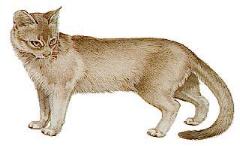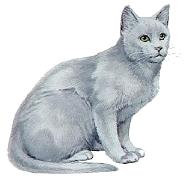


Owning a ... cat
Start here!
Before buying a cat, remember that it is your responsibility to care for it every day of its life, which may be for 14 years or more.
Breeds
Some of the most popular cat breeds are listed here. For more details visit Cat Fanciers where you can find in-depth FAQS for all cat breeds.






Choosing a cat
It is important that you get your cat from a reputable breeder. This guarantees the health and wellbeing of the cats. Check your local vet for adverts, since there may be a litter of kittens in your area. If getting kittens from an advert, always make sure they have come from a healthy environment and give them a thorough check-up before choosing one. Always see the kittens with their mother.
By far the best place to look is at your local rescue centre. There are thousands of unwanted cats needing a new home and by going to a rescue centre you can get a good idea of the character of your cat plus any health issues you need to take care of. You will also be able to spend some time with the cat to see if it is right for you. If you are looking for a kitten, they are often available at rescue centres but will be rehomed more quickly than adult cats. If you enquire regularly kittens will be easier to get hold of.
When choosing a cat, make sure that it is healthy. Look for the following things:
1. Clean eyes with no discharge
2. Clean, erect ears
3. Clean teeth and healthy, pink gums
4. A moist nose free from discharge
5. A clean bottom with no staining around the base of the tail.
6. A silky, clean coat
7. A smooth gait with no limp
8. A healthy appetite
9. A lively, inquisitive nature
10. Not the runt of the litter
It is impossible to tell how a kitten will turn out when it is fully grown. Some will be timid, some playful and outgoing, others aggressive, some will be house cats, some will love to roam. If getting an adult cat, its personality will be obvious and it is often easier to choose a cat suited to you. As to which breed you choose, there are some differences in behaviour between each breed, for example Siamese cats tend to wail a bit. The main difference comes in the appearance - long or short haired, sleek or heavily built. Bear in mind that long haired varieties will need regular grooming.
Male or female?
Males (toms) and females (queens) will have different physical appearances. Toms tend to be bigger and more solidly built, with larger more masculine features. Queens are much more delicate and pretty, with fine features. Toms spray urine to mark their territory and they often do this in the house - castration can help to reduce this - but this may put you off a tom. Queens do not spray, except in some rare cases (see FAQ's). Queens will need to be spayed to prevent toms invading your garden and getting up to mischief. Subsequently it is a good idea to castrate toms, too, in order to prevent unwanted litters. Toms may be slightly more outgoing and aggressive than queens.
The Abyssinian (left) has a short, ticked coat and is thought to be related to the cats pictured in Ancient Egyptian art.
The Balinese (below) is a beautiful, long-haired cat similar to the Siamese.
The Bombay is a short-haired cat, jet black in colour and with copper eyes.
The British Shorthair is a large, thickly furred cat which is also very tough.
The Burmese (below) was produced by crossing a Siamese cat with a cat native to Burma. It has a short, sleek coat.
The Cornish Rex has short, silky fur with big ears and a slender body.
The Devon Rex is similar to the Cornish Rex but with a curlier, coarser coat.
The Manx cat (below) does not have a tail. It has a thick coat, an arched back and long, muscular hind legs.
The Oriental is similar to the Siamese except without the dark markings.
The Persian has a thick coat with a short nose and big eyes.
The Russian Blue (below left) has a very thick, short, blue coat.
Site design and content © Charlotte Owen 2003